Kothari D.P., Nagrath I.J. Modern Power Systems Analysis
Подождите немного. Документ загружается.

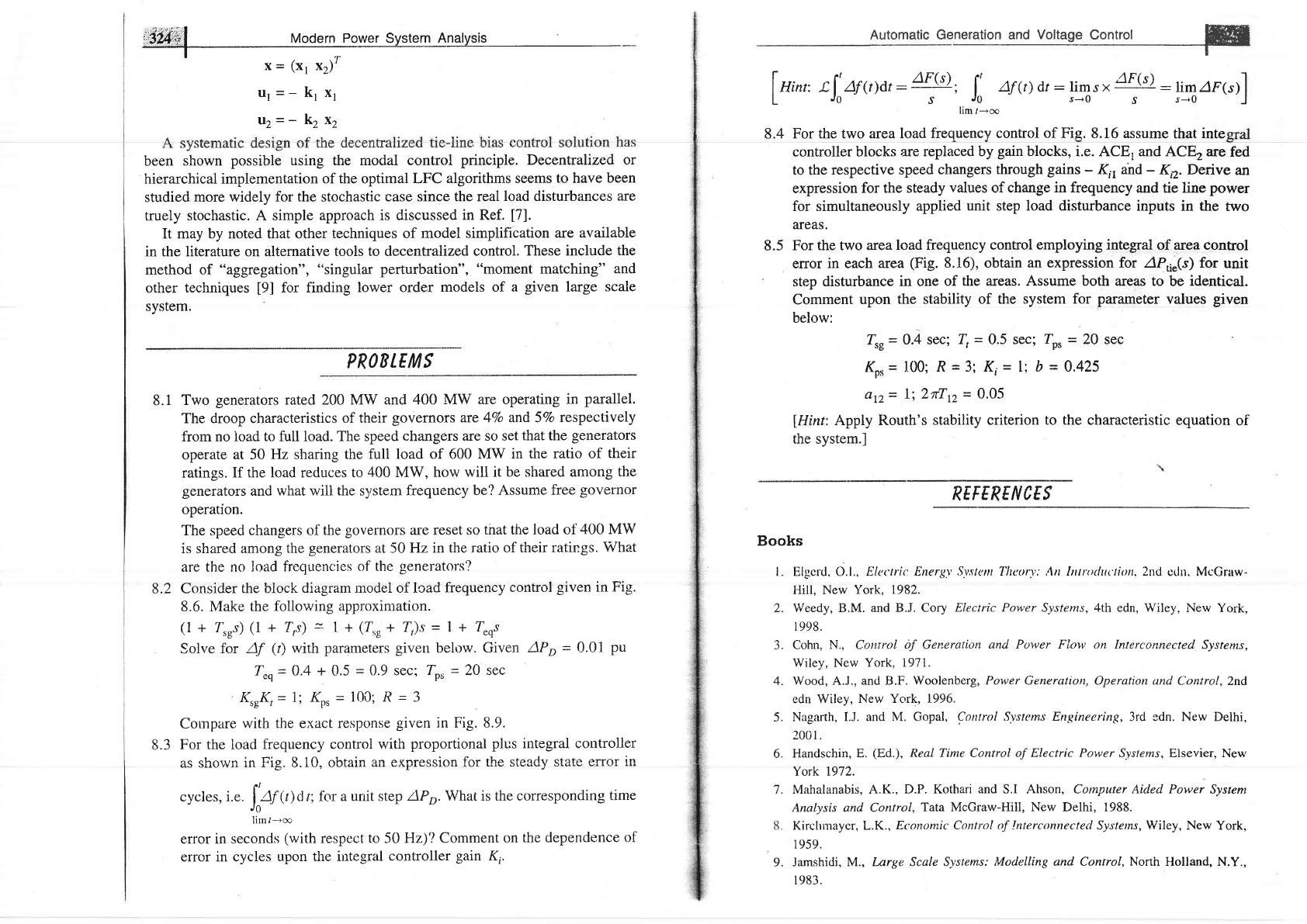
i,i2[,:*.1
Modern
Power
System
Analysis
-
4
x
-
(x1
x2)'
ut=-ktxt
u2--
kzxz
been
shown
possible using the modal control
principle. Decentralized or
hierarchical implementation
of the optimal LFC
algorithms seems
to have been
studied
more widely
for the stochastic case since
the real
load disturbances
are
truely
stochastic. A simple
approach is discussed
in Ref.
[7].
It may by noted that other
techniques of
model simplification
are available
in the
literature on alternative
tools to decentralized
control.
These include
the
method
of
"aggregation",
"singular
perturbation",
"moment
matching"
and
other
techniques
[9]
for finding
lower order
models of
a
given
large scale
system.
PROB
IE
I/I
S
Two
generators
rated 200
MW and 400
MW are operating
in
parallel.
The droop characteristics
of their
governors are 47o and 5Vo
respectively
from no load
to full load. The speed
changers
are so set
that the
generators
operate
at 50
Hz sharing the full
load of 600 MW
in the
ratio of
their
ratings. If
the load reduces to
400 MW, how
will it
be shared among
the
generators
and
what
will
the s)/stem frequency
be? Assume
free
governor
operatlon.
The speed
changers of the
governors
are reset so
that the
load of
400 MW
is shared among
the
generators
at
50
Hz in the ratio
of their ratings.
What
are the no load
frequencies
of the
generators?
Consider
the block
diagram model of lcad
frequency
control
given
in
Fig.
8.6. Make
the following
approximatron.
(1
+ Z.rs)
(1
+ Z,s)
=-
t +
(7rg
+ T,),s
=
1 + Z"c.r
Solve
for Af
(l)
with parameters
giveu
below.
Given
AP,
-
0.01
pu
T"q=
0.4 + 0.5
=
0.9 sec;
70,
=
20 sec
KrrK,=1;
Kpr=100;
R=3
Coinpare
with the exact response
given
in Fig. 8.9.
For
the load frequency
control
with
proportional
plus integral controller
oc olrn'rn.i- Tiic e 1n nhfain en AsnrAccinn fnr tha cfenrlrr cfrfp errnr in
clJ orlvYYll
ll( L L6. v.
rvt vuLarrr
cycles, i.".
f'41t)d
r; for
a urrit step
APr. What is the corresponding
time
t^"
,1,
lirnl*m
error in seconds
(with
respect
to
50
Hz).lComment
on
the
dependence
of
error
in cycles
upon the integral
controller
gain
K,.
Automatic Generation
and
voltage
Control
ffi
I
n,n,,
tf^461dv
-
aF(s)
'
1'
af
(t)dr
:
liq,
*
'4F(s)
:
hm/F(")]
L
JO
,t
JO
s-0
S
s+0
8.4
For the two area load
frequency
control of
Fie. 8.16 assume
that inte
controller blocks
are replaced by
gain
blocks,
i.e. ACEI and
ACE are
fed
to the
respective speed
changers through
gains
-
K, and
-
Ko. Derive
an
expression
for the
steady
values
of change
in
frequency and tie
line
power
for simultaneously
applied
unit
step
load disturbance
inputs in the
two
areas.
8.5
For the two area
load frequency
control employing integral
of area control
error
in
each
area
(Fig.
8.16), obtain
an expression
for AP6"$) for
unit
step disturbance
in one
of the areas. Assume both areas
to be
identical.
Comment
upon
the stability of the
system for
parameter
values
given
below:
4e
=
0'4 sec;
Z,
=
0'5
sec;
Kpr=
100; R=3; Ki=
l; b
ar2= I;2tTr,
=
0.05
lHint:
Apply
Routh's
stability criterion
the system.l
Zp.
=
20 sec
=
0.425
to the
characteristic equation
of
8.1
8.2
REFERE
N
CES
Books
l. Elgcrd, O.1.,
Elccu'ic Energv.Sv,s/clr T'lrcorv: An ltttnxlut'lion. 2nd
cdn.
McCraw-
Hill, New York,
1982.
2.
Weedy, B.M. and
B.J. Cory
Electric
Pow'er Systems,4th edn, Wiley,
New York,
I
998.
Cohn,
N.,
Control
of Generation
and Power Flou, on Interconnected
Systents,
Wiley, New
York, i971.
Wood,
A.J., and B.F.
Woolenberg, Power
Generation, Operation
and
Control,2nd
edn Wiley,
New York, 1996.
Nagarth,
I.J. and M. Gopal,
Control Systems Engineering,
3rd edn. New Delhi,
200 l.
Handschin,
E.
(Ed.),
Real
Time
Control
of Electric Power
Systems, Elsevier, New
York
1972.
Mahalanabis,
A.K.,
D.P. Kothari and S.I Ahson, Computer Aided Power
Systent
Analysis and Control,
Tata McGraw-Hill, New Delhi, 1988.
Kirclrrnayer,
L.K.,
Economic Control
of lnterconnected
Systems,
Wiley,
New York,
t959.
Jamshidi,
M., Inrge Scale System.s:
Modelling and
Control, North Holland, N.Y.,
1983.
a
1
4.
5.
6.
7.
8.
9.
8.3
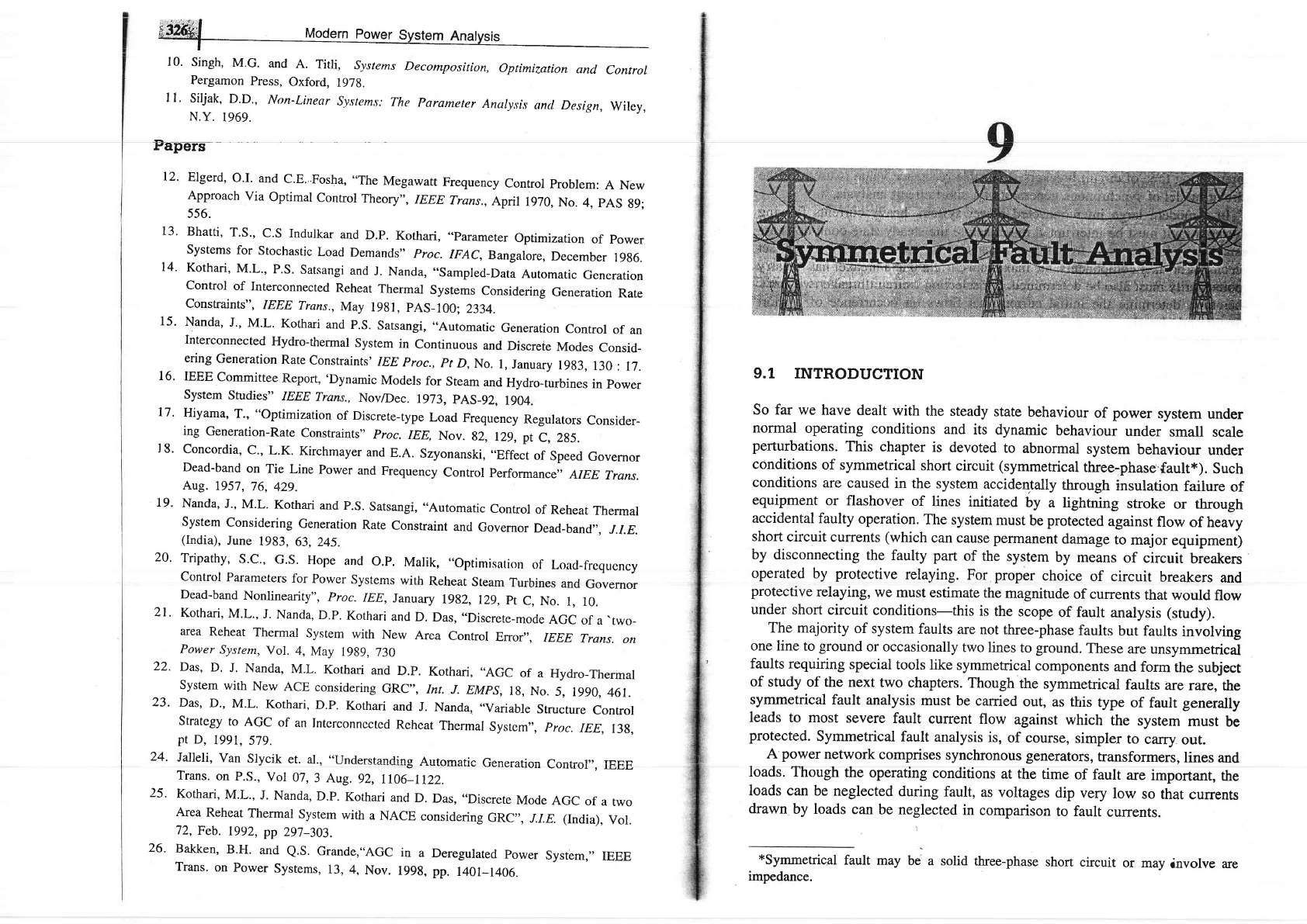
10.
Singh,
M.G.
and
A.
Titli,
Systems
Decomposition,
Optimization
and
Control
Pergamon
Press,
Oxford,
197g.
I
I'
Siljak,
D'D.,
Non-Linear
Systems:
The
Parametcr
Analysis
antl
Design,
Wiley,
N.Y.
1969.
.t,apers
12.
Elgerd,
o.I.
and
c.E..Fosha,
"The
Megawatt
Frequency
control
problem:
A
New
Approach
via
optimal
control
Theory",
IEEE
Trans.,
April
1970,
No.
4,
pAS
g9:
556.
13'
Bhatti,
T'S.,
C.S
Indulkar
and
D.P.
Kothari,
"Parameter
optimization
of
power
Systems
for
Stochastic
Load
Demands"
Proc.
IFAC.
Bangalore,
December
19g6.
l4'
Kothari,
M'L.,
P.S.
Satsangi
and
J.
Nanda,
"sampled-Data
Automatic
Generation
Control
of
Interconnected
Reheat
Thermal
Systems
Considering
Generation
Rate
Constraints",
IEEE
Trans.,
May
19g1,
pAS_100;
2334.
15'
Nanda,
J',
M.L.
Kothari
and
P.S.
Satsangi,
"Automatic
Generation
Control
of
an
Interconnected
Hydro-thermal
system
in
continuous
and
Discrete
Modes
consid-
ering
Generation
Rate
constraints'
IEE
proc.,
prD,
No.
l,
January
19g3,
130
: 17.
16'
IEEE
committee
Report,
'Dynamic
Models
for
Steam
and
Hydro-turbines
in
power
system
studies"
IEEE
Trans.,
Nov/Dec.
rg73,
pAS-92,
1904.
l7'
Hiyama,
T', "Optimization
of Discrete-type
Load
Frequency
Regulators
Consider-
ing
Generation-Rate
constraints"
proc.lE4
Nov.
g2,
r2g, pt
c, 2g5.
I8.
concordia,
c.,
L.K.
Kirchmayer
and
E.A.
Szyonanski,
..Effect
of
speed
Governor
Dead-band
on
Tie
Line
Power
and
Frequency
Control
performan
ce,,
AIEE
Trans.
Aug.
1957,
76,429.
19'
Nanda,
J',
M.L.
Kothari
and
P.S.
Satsangi,
"Automatic
Control
of
Reheat
Thermal
System
Considering
Generation
Rate
Constraint
and
Covernor
Dead-band,,.
J.I.E.
(India),
June
1983,
63,245.
20.
Tripathy,
s.9.,
G.s.
Hope
and
o.p.
Marik,
,,optimisatiorr
of
Load-frcqucncy
C<lntrol
Parameters
for
Power
systems
with
Reheat
Steam
Turbines
and
Governor
Dead-band
Nonlinearity",
proc.
IEE,
January
rgg2,
rzg,
pt
c,
No.
r,
r0.
21.
Kothari,
M.L.,
J.
Nanda,
D.p.
Kothari
and
D.
Das,.,Discrete-mode
AGC
of
a.two_
area
Reheat
Thermal
system
with
New
Area
control
Error,,,
IEEE
Trans.
on
Power
System,
Vol.
4,
May
19g9,
730
22'
Daq
D.
J.
Nanda,
M.L.
Kothari
and
D.p.
Kothari,
,.AGC
of
a
Hydro_Thermal
system
with
New
ACE
considering
GRC",
Int.
J.
EMps,1g,
No.
5,
rggo,
46r.
23'
Das,
D',
M.L'
Kothari,
D.P.
Kothari
and
J.
Nanda,
"Variable
Structure
Control
strategy
to
AGC
of
an
Intcrconncctcd
Rcheat
Thermal
systcm,,,
prctc.
IEE,
r3g,
pt
D,
1991,
579.
Jalleli,
Van
Slycik
et.
al.. "lJndersfanding
Autonnatic
Generation
Control,,,
IEEE
Trans.
on
P.S.,
Vol
07,
3
Aug.
92,
1106_1122.
Kothari,
M.L.,
J.
Nanda,
D.p.
Kothari
and
D.
Das,
,,Discrete
Mode
AGC
of
a
two
Area
Reheat
Thermal
System
with
a NACE
considering
GRC,,,
J.LE.
(rndia),
vol.
72,
Feb.
1992,
pp
Zg7-303.
Bakken,
B.H.
and
e.s.
Grande,"AGC
in
a
Deregulated
power
system,,,
IEEE
Trans.
on
Power
Systems,
13,
4,
Nov.
199g,
pp.
1401_1406.
24.
25.
26.
9.1
INTRODUCTION
So
far we have
dealt
with
the steady
state
behaviour
of
power
system
under
normal
operating
conditions
and
its
dynamic
behaviour
under
small
scale
perturbations.
This
chapter
is
devoted
to
abnormal
system
behaviour
under
conditions
of
symmetrical
short
circuit
(symmetrical
three-phase.fault*).
Such
conditions
are caused
in
the system
accidentally
through
insulation
failure
of
equipment
or flashover
of
lines
initiated
by
a lightning
stroke
or through
accidental
faulty
operation.
The
system
must
be
protected
against
flow
of heavy
short
circuit
currents
(which
can cause peffnanent
damage
to
major
equipment)
by
disconnecting
the
faulty part
of the
system
by
means
of
circuit
breakers
operated
by
protective
relaying.
For
proper
choice
of
circuit
breakers
and
protective
relaying,
we
must
estimate
the
magnitude
of
currents
that
would
flow
under
short circuit
conditions-this
is
the
scope
of fault
analysis
(study).
The
majority
of
system
faults
are
not three-phase
faults
but faults
involving
one line
to
ground
or occasionally
two
lines
to
ground.
These
are
unsymmetrical
faults
requiring
special
tools like
symmetrical
components
and
form
the subject
of
study
of the next
two
chapters.
Though
the
symmetrical
faults
are
rare,
the
symmetrical
fault analysis
must
be carried
out,
as this
type
of
fault generally
leads
to most
severe
fault
current
flow
against
which
the system
must
be
protected.
Symmetrical
fault
analysis
is,
of course,
simpler
to
carry
out.
A
power
network
comprises
synchronous
generators,
ffansfonners,
lines and
loads.
Though
the operating
conditions
at the
time
of fault
are
important,
the
loads can
be neglected
during
fault,
as voltages
dip
very
low
so
that
currents
drawn
by loads
can
be neglected
in
comparison
to fault
currents.
*Symmetrical
fault
impedance.
may
be
a solid
three-phase
short
circuit
or
may
involve are
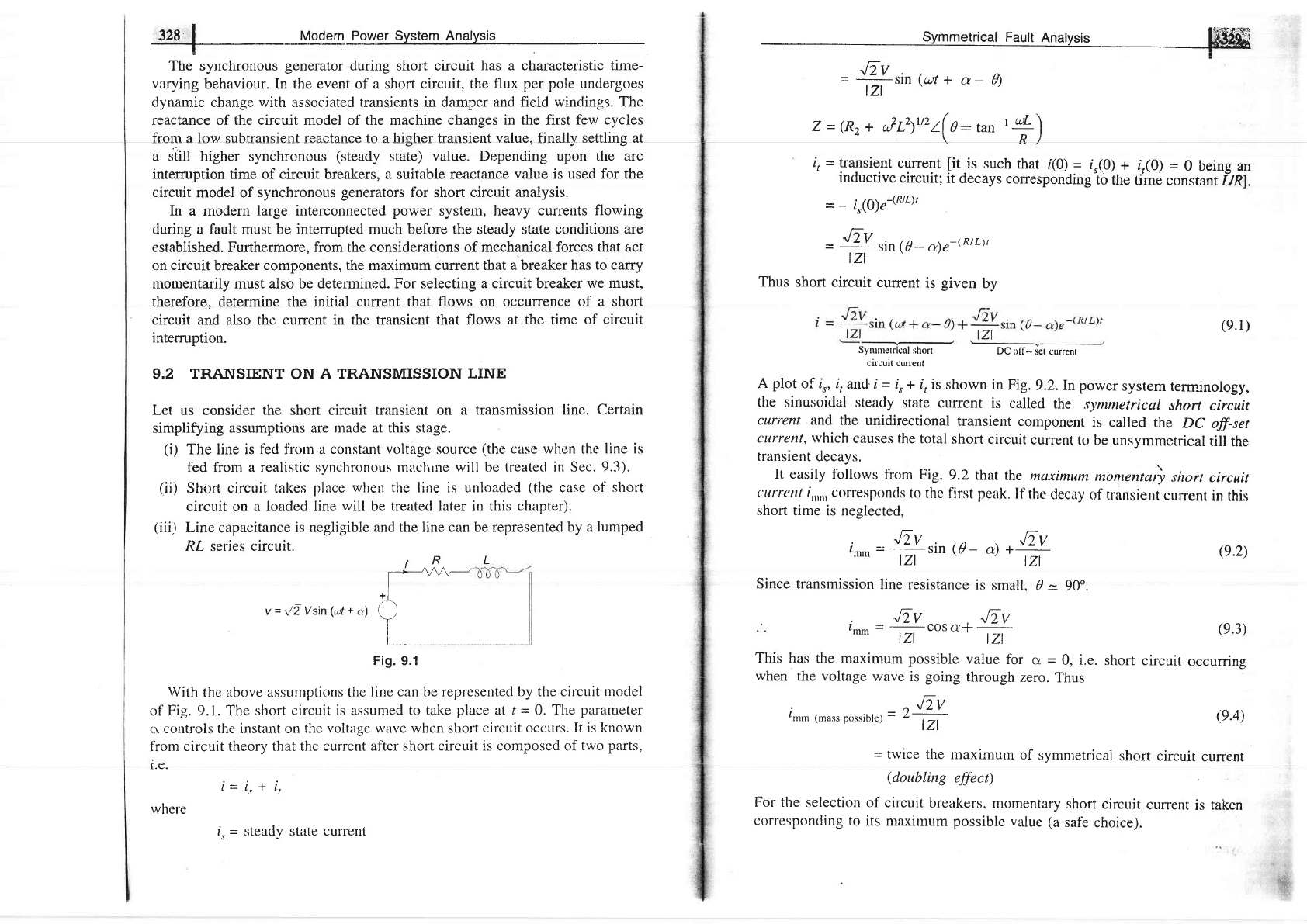
325
|
Modern Power
System Analysis
t
The
synchronous
generator
during short circuit has a characteristic
time-
varying
behaviour. In the event of a short circuit,
the flux
per pole
undergoes
dynamic change with associated transients in damper
and field
windings.
The
reactance of the circuit model of the machine changes
in
the first
few cycles
from a low subtransient reaetanec to a higher transient
value,
finally
settling at
a s'iitt
higher synchronous
(steady
state) value. Depending upon
the arc
intemrption time of circuit breakers, a suitable reactance
value is used for the
circuit
model of
synchronous
generators
for short circuit analysis.
In
a modern large interconnected
power
system, heavy currents
flowing
during a fault must be interrupted much before
the steady state conditions
are
established.
Furthermore,
from the considerations of mechanical forces
that act
on
circuit
breaker
components, the maximum current that a breaker
has to carry
momentarily must also be determined.
For
selecting
a circuit breaker
we must,
therefore, determine the initial current
that flows on occulTence
of a short
circuit
and also the
current in the transient that flows
at the time of
circuit
intemrption.
9.2 TRANSIENT ON A
TRANSMISSION LINE
Let
us
consider
the short circuit transient on a
transmission line. Certain
simplifying assumptions are made at this stage.
(i)
The line is led I'rorn
a constant
voltagc
soLrrcc
(tlte
case whcn the
line is
fed from
a
realistic synchronons ma.chrne will tre treated
in Sec.
9.3).
(ii)
Short
circuit
takes
place when the line
is unloaded
(the
case
of
short
circuit on
a
loaded
line will be treated later in this
chapter).
(iii)
Line
capacitance
is
negligible and the line can be represented
by a lumped
RZ series circuit.
, ,F.
L
r+V\'\-'
.l
v
=
JI
vsin
(o,t
+
*)
rV)
I
i_
Fig.
9.1
With
the above
assumptions the
line can be representecl
by
the circuit
rnoclel
of Fig.
9.1
. The
short circuit is
assumed to take
place
at t
=
0.
The
parameter
<r controls the instant on
the voltage wave when short
circuit occLrrs. It is
known
from
circuit theory that the
current after short
circuit is composed of
two
parts,
1.tr.
t--
I"+ I.t
whcre
i,
=
steady state
current
tffiffi
I
42V
=
--*sin
(cr,rf
+ a_
A
lzl
ir
=
transient
current
[it
is
such
that
t(0)
=
t(0)
+
L(0)
=
0 being
an
inductive
circuit;
it
decays
correspondingio
the
tim6
constant
iRl.
=
-
i,(6)e-$tL)t
=
9Y
sin
(d-
a)g-.(RtDt
tzl
Thus
short circuit
current
is
given
by
z
=
(Rz
+
Jr\tt"(t:
tan-l
+)
Synrnretrical
short
circuit
current
DC
otT- set
curnent
A
plot
of i* i,
and'i
=
i, +
i, is shown
in
Fig.
9.2.rnpower
system
terrninology,
the sinusoidal
steady
state
current
is called
the
symmetrical
short
circuit
current
and the
unidirectional
transient
component
is
called
the
DC
off-set
current, which
causes
the
total
short
circurit
current
to be
unsymmetrical
till
the
transient
decays.
It easily
follows
fiom
F'ig.
currcnt
i,,,,,,
corresponds
to
the
short
time is neglected,
9.2
that
the maximum
momenro)
short
circuit
first
penk.
If
the
clecay
of
trnnsient
current
in this
(e.1)
(e.2)
(e.3)
-
Jrv'sin
(d-
c)
*
E'
lzl
tzl
Since
transmission
line resistance
is
small.
0
-
9C,.
. Jiv
JTv
Im*
=
rzr
cosa+
rzl
This has the maximum
possible
value
for
o.
=
0,
i.e.
short circuit
occurring
when
the
voltage wave
is
going
through
zero.
Thus
i,n,n
lrnu*
possible)
=
'#
e.4)
=
twice the
maxirnum
of
symmetrical
short
circuit
current
(doubling
effect)
For the selection
of
circuit
breakers.
momentary
short
circuit
current
is taken
corresponding
to
its maxirnum possible
value
(a
sat'e
choice).
.w
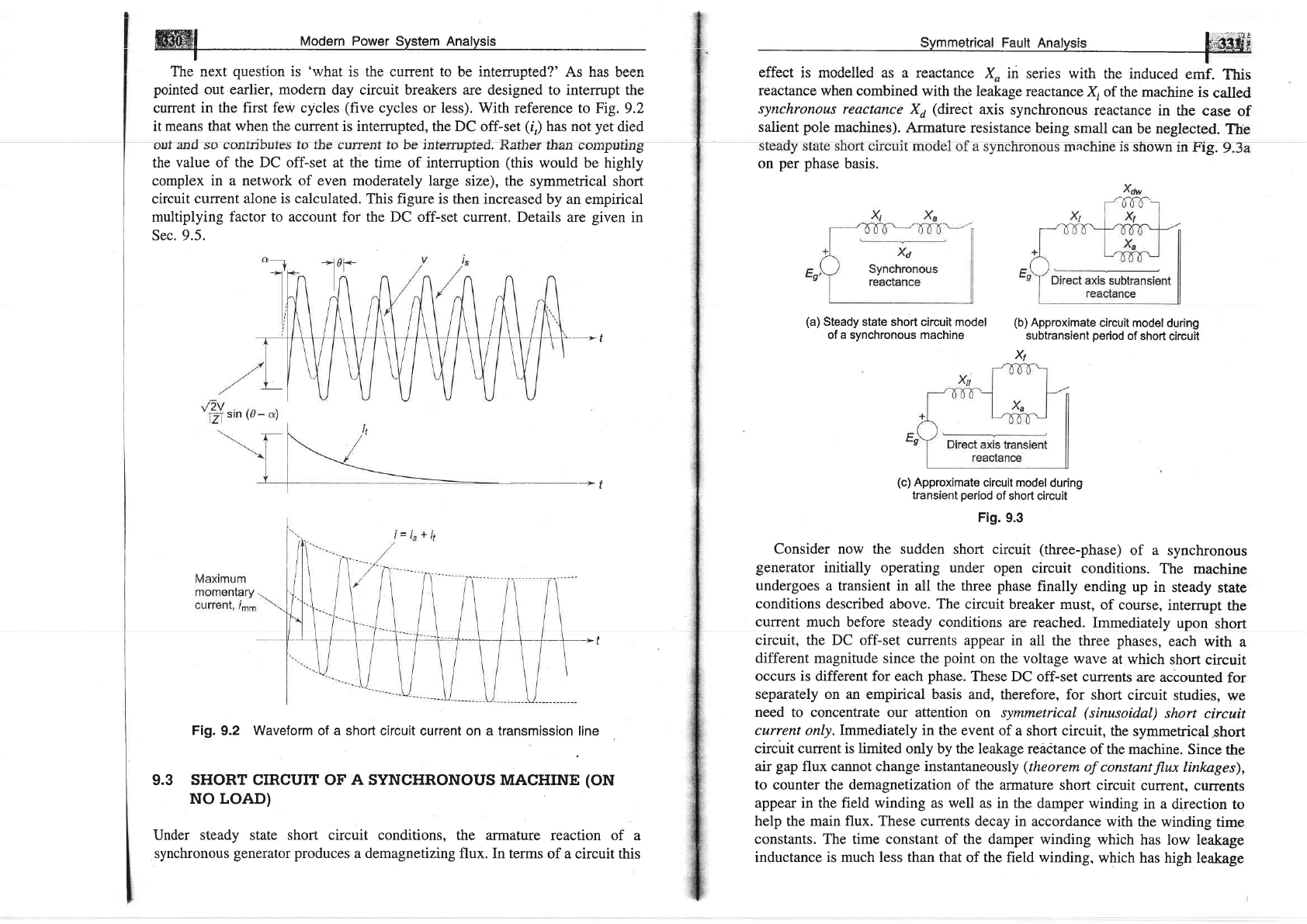
ffiffif
Modern Power
System Analysis
The nevf ntrecfinn ic
turhqf
ic fhc r.rrrrcnf fn hc inferrrrnfprl?t Aa hqo haan
el/lvs
pointed out earlier, modern
day circuit breakers
are designed to intemrpt the
cunent
in the first
few
cycles
(five
cycles or less).
With reference to Fig,
9.2
it
means that when the current
is intemrpted, the DC
off-set
(i,)
has not
yet
died
the
value of the DC off-set
at the time of intemrption
(this
would
be highly
complex in a network of even
moderately large size),
the symmetrical short
circuit
current alone is calculated.
This figure is then increased
by an empirical
rnultiplying
factor to account
for
the
DC off-set current. Details are
given
in
Sec. 9.5.
Fig.
9.2
Waveform
of a short circuit
current on a transmission line
9.3 SHORT CTRCUTT OF
A
SYNCHRONOUS MACHTNE
(ON
NO LOAD)
Under steady state short circuit conditions, the armature
reaction of
a
synchronous
generator produces
a demagnetizing
flux. In terms
of a circuit this
b,a#&
reactance
when combined
with the leakage
reactance
Xi of
the machine
is
called
synchronous
reactance
X4
(direct
axis
synchronous
reactance
in
the case
of
salient
pole
machines).
Armature
resistance
being
small can
be neglected.
The
ne ls
snown
ln rrg.
on
per
phase
basis.
(a)
Steady state
short circuit model
of a
synchronous machine
(b)
Approximate
circuit
model during
subtransient
period
of short
circuit
X1
(c)
Approximate
circuit model
during
transient
period
of
short circuit
Fig.
9.3
Consider now the sudden
short circuit
(three-phase)
of a
synchronous
generator
initially
operating under open
circuit
conditions.
The machine
undergoes
a transient in all the three phase
finally ending
up in
steady
state
conditions described above.
The circuit
breaker
must,
of course,
intemrpt
the
current
much before steady conditions
are reached.
Immediately
upon
short
circuit, the DC off-set currents
appear
in all the
three
phases,
each with
a
different
magnitude since the
point
on the voltage
wave
at which
short
circuit
occurs is different for
each
phase.
These DC
off-set currents
are accounted
for
separately on an empirical basis
and, therefore,
for short
circuit
studies,
we
need
to concentrate our attention on
syimmetrical
(sinusoidal)
short
circuit
current
only.Immediately
in
the event of
a short circuit,
the
symmetrical.short
circuit current is
limited
only by the leakage reaitance
of
the machine.
Since
the
air
gap
flux cannot change instantaneously
(theorem
of constant
flux
linkages),
to
counter
the demagnetization
of
the
armature short
circuit
current, currents
appear
in the field
winding
as
well
as in the damper
winding
in a
direction
to
help the main flux. These currents decay in
accordance
with
the
winding
time
constants.
The time constant of the damper winding
which
has low leakage
inductance is much less than that
of the field winding,
which
has high
leakage
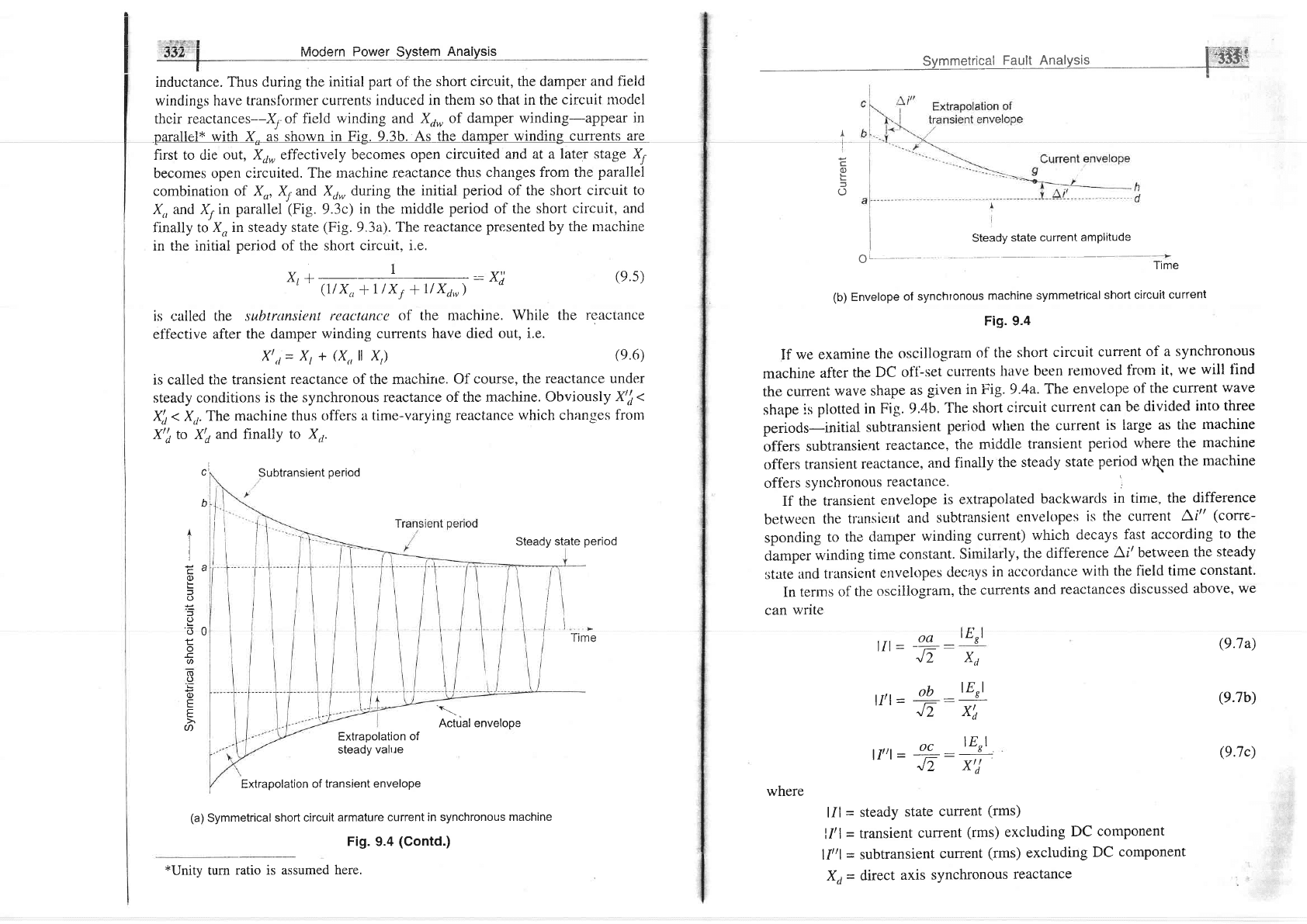
Mocjern
Power
Sysiem
nnaiysis
inductance.
Thus during the
initial
part
of the
short circuit, the damper
and field
windings have
transfurnrer
currents induced in
them
so
that in the
circr,rit model
thcir reactances--X,
of field
winding and Xa* of
damper
winding-appear in
parallelx with
Xo
as shorvn in Fig. 9.3b.
As the
danqpqlruadlag cullqqls 4!q
first to die
out, Xr* effectively becomes
open
circuited
and at a later stage X1
becomes open
circuited. The rnachine reactance
thus chauges
from the
parallel
combination of Xo, Xy and
Xu. during the initial
period of the short circuit
to
X,,and Xrinparallel
(Fig.9.3c)
in the rniddle
per:iod of the short circuit, and
finally to
X,, in steady state
(Fig.
9.3a).
The reactance
presented
by
the machine
in the initial
period
of the short circuit,
i.e.
X.
-r- -
1_-
:
X'j
L
(11x,,+UXJ+llxd,,)
"
(e.5)
is called the
subtrunsient
reoctutxc:e <>f
the
nrachine.
While
the
reactance
effective after
the darnper
winding currents have died
out, i.e.
X',t=
X, +
(X,,ll
X,)
(e.6)
is called the
transient
reactance of the machirre.
Of course, the
leactance
under
steacly conditions
is the
synchronous reactance
of the machine.
Obviousiy
Xf7
<
X'd
<
Xu.
The machine
thus offers
a time-varying
reactance which changes
front
Xttoto Xtaand
finally to
Xn.
Subtransient oeriod
Steady state
period
Extrapolation
of
steady valrre
Extrapolation
of transient
envelope
(a)
Symmetrical
short circuit
armature
current in synchronous
machine
Fig.
9.4
(Contd.)
Time
i
Actual
envelope
I
b
l
I
I
I
I
Ea
q)
f,
()
g
'o0
t
a
o
o
E
E
a
*Unity
turn ratio
is assumed
here.
symmerrical
Fault Analysis
I'lt,5ffit
Steady
state
current
amPlitude
(b)
Envelope
of synchronous
machine
symmetrical
short circuit
current
Fig. 9.4
If
we examine
the
oscillograrn
of the
short
circuit
current
of a
synchronous
machine
after
the
DC
ott-set
cuitents
have been
rettroved
trom
it,
we
will
tind
the
current
wave
shape
as
given in Fig. 9.4a.
The
envelope
of
the current
wave
shape
is
plotted
in Fig.
9.4b,
The
short
circuit
current
can be divided
irtto
three
periods-initial
subtransient
period when
the
current
is large
as tire
tnachine
offers
subtransient
reactance,
the
middle
transient
period
where the
machine
offers
transient
reactance,
and finally
the
steady
state
period w\n the
machine
ofters
synchronous
reactance.
:
If the
transient
envelope
is extrapolated
backwards
in tinre, the
difference
betwecn
the
tlansicrrt
ancl subtransiertt
envelopes
is
the cunent
Ai/'
(corre-
sponding
to the
clamper
winding
current)
which
decays
fast
according
to the
clamper
winding
time
constant.
Similarly,
the
difference
Ai/ between
the steady
state
1nd
transicnt
envelopes
decays
in
accordance
with
the field
time
constant.
In
terms
of
the
oscillogram,
the
cunents
and
reactances
discussed
above,
we
can
wrlte
lEsl
Y,
tltt
=
32.:
Y+
J2
X,J
where
l1l
=
steady
state
current
(rms)
!//l
=
transient
current
(rms)
excluding
DC
component
lltl
=
subtransient
current
(rms)
excluding
DC
component
Xa
=
direct
axis
synchronous
reactance
I
I
0)
Tlme
lIl
=
lll
=
oa
t;
\t z.
ob
t;
\IL
_lE8l
xtd
(9.7a)
(e.7b)
(9.7c)
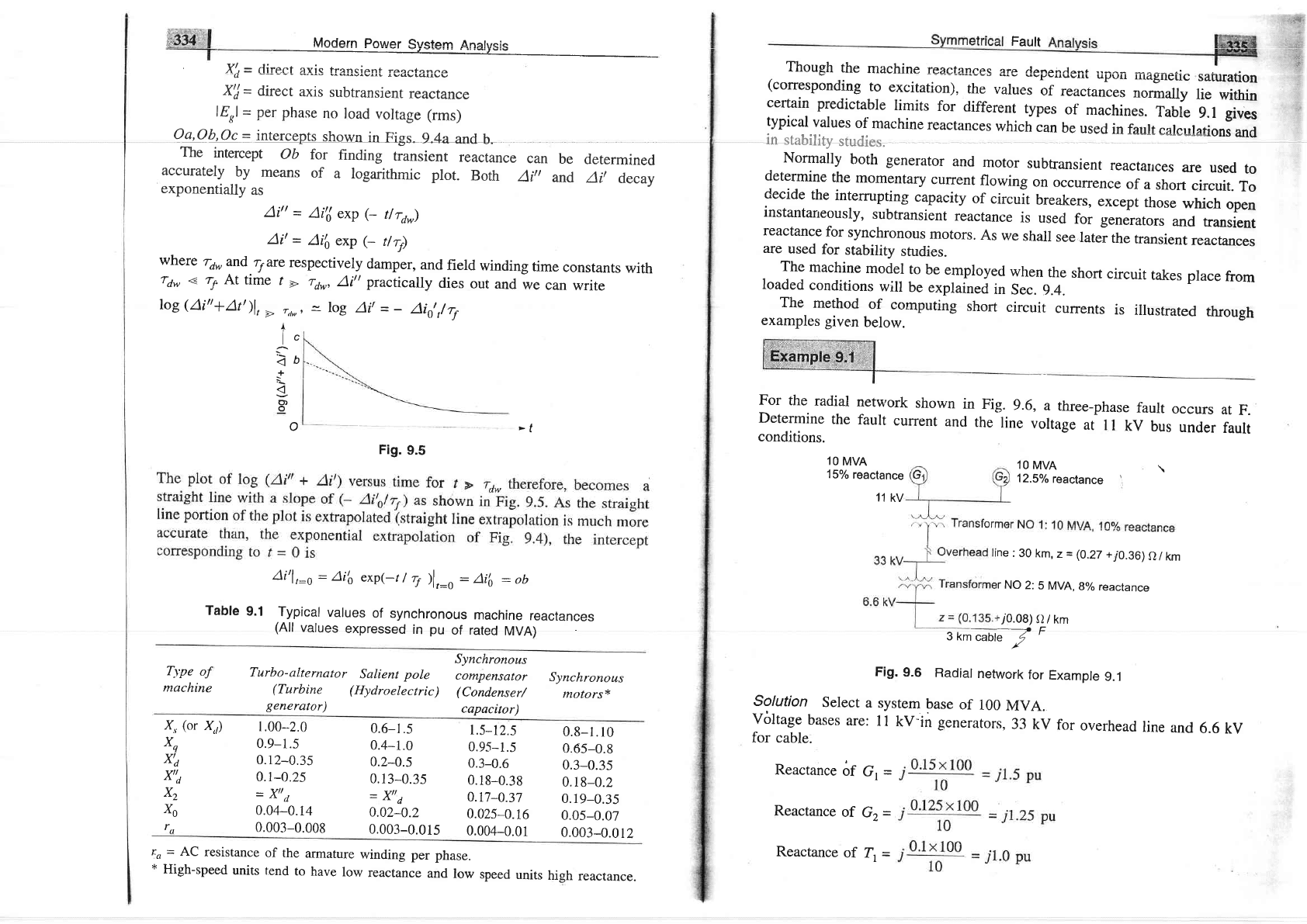
Modern
Power Svstenn Anelveie
Xtd=
direct
axis
transient
reactance
X'j
=
direct
axis
subtransient
reactance
lErl
=
per
phase
no
load
voltage
(rms)
Oa,Ob,Oc
=
intercepts
shorvn
iLEigs-
9Aa
and,
b_
The
intercept
Ob
for
finding
transient
reactance
can
be
determined
accurately
by
means
of
a logarithmic
plot.
Both
Ai,
and
al
decav
exponentially
as
Aitt
=
Ai(
exP
(-
t/q,)
Ait
=
Ai6
exp
1_
t/r7)
where
r4,
and
rf are
respectively
damper,
and
field
winding
time
constants
with
Td*
4
ry
At time
/
2'
r4*,
Aitt practicalry
dies
out
and
we
can
write
log
(Aitt+
At,)1,
,
,
-
log
Ai'
=
-
Aint
,/
ry
Fig.
9.5
Ai,l,:o
:
Aito
exp(-r
/
,t
)1,:o
:
Ai,o
:
ob
Table
9.1
Typical
values
of
synchronous
machine
reactances
(All
values
expressed
in
pu
of rated
MVA)
Trl*
t
lc
-
ab
*+
g
O)
o
o
rf
Type
of
machine
Turbo-alternator
Salient
pole
(Turbine
(Hydroelectric)
generator)
Synchronous
compensator
(Condenser/
capacitor)
Synchronous
motors*
X,
(or
X,)
X^
.t
xd
xti
x2
xo
ru
l.00--2.0
0.9-1.s
0.12-0.35
0.r-0.25
_
x,d
0.04-0.14
0.003-0.008
0.6-1.5
0.4-1.0
0.2-0.5
0.13-0.35
_
x,d
0.02-0.2
0.003-0.01s
r.5-r2.5
0.95-1.5
0.3-0.6
0.18-0.38
0.17-0.37
0.025-0.16
0.004-0.01
0.8-1.10
0.65-0.8
0.3-0.35
0.18-0.2
0.19-0.35
0.05-0.07
0.003-0.012
ro
=
AC
resistance
of
the
armature
winding
per
phase.
*
High-speed
units
tend
to
have
low
reactance
and
low
speed
units
high
reactance.
Fault
pon
ii'ragn-tir
rutlrarion
f:T:jr:lltlq
j?
",l"ilirion),
rhe
values
tf
reactances
normally
rie
within
certain
predictable
limits
for
different
types
of
machines.
Tabie
9.r
gives
typical
values
of
machine
reactances
which
can
be
userj
in
fault
calculations
and
in
stability
studies.
Normally
both
generator
and
motor
subtransient
reactances
are
used
to
determine
the
momentary
current
flowing
on
occurrence
of
a
short
circuit.
To
decide
the
intemrpting
capacity
of
circuit
breakers,
except
those
which
open
instantarreously,
subtransient
reactance
is
used
for
generators
and
transient
reactance
for
synchronous
motors.
As
we
shall
see
later
the
transient
reactances
are
used
for
stability
studies.
The
machine
model
to
be
employed
when
the
short
circuit
takes
place
from
loaded
conditions
will
be
explained
in
Sec. 9.4.
The
method
of
computing
short
circuit
currents
is
illustrated
through
examples
given
below.
'ii#I:
n
s
For
the
radial
network
shown
in
Fig.
9.6,
a
three-phase
fault
occurs
at
F.
Determine
the
fault
current
and
the
line
voltage
at
l l
kv
bus
under
fault
conditions.
1O
MVA
15%
reactance
11
kV
10
MVA
\
12.5oh
reactance
\
ne
: 3o
km,
z
=
(0.27
+
jo.3e
a/
km
r
NO
2:
5
MVA,
8oh
reaclance
riO.0B)
o
/ km
z
xn
caote
/
F
Fig.
9.6
Radial
network
for
Example
g.1
Solution
Select
a
system
base
of
100
MVA.
V6ltage
bases
are:
I
I
kV-in generators,
33
kV
for
overhead
line
and
6.6
kV
for
cable.
Reactance
of
G,
=
Reactance
of
G2
-
Reactance
of
Z,
=
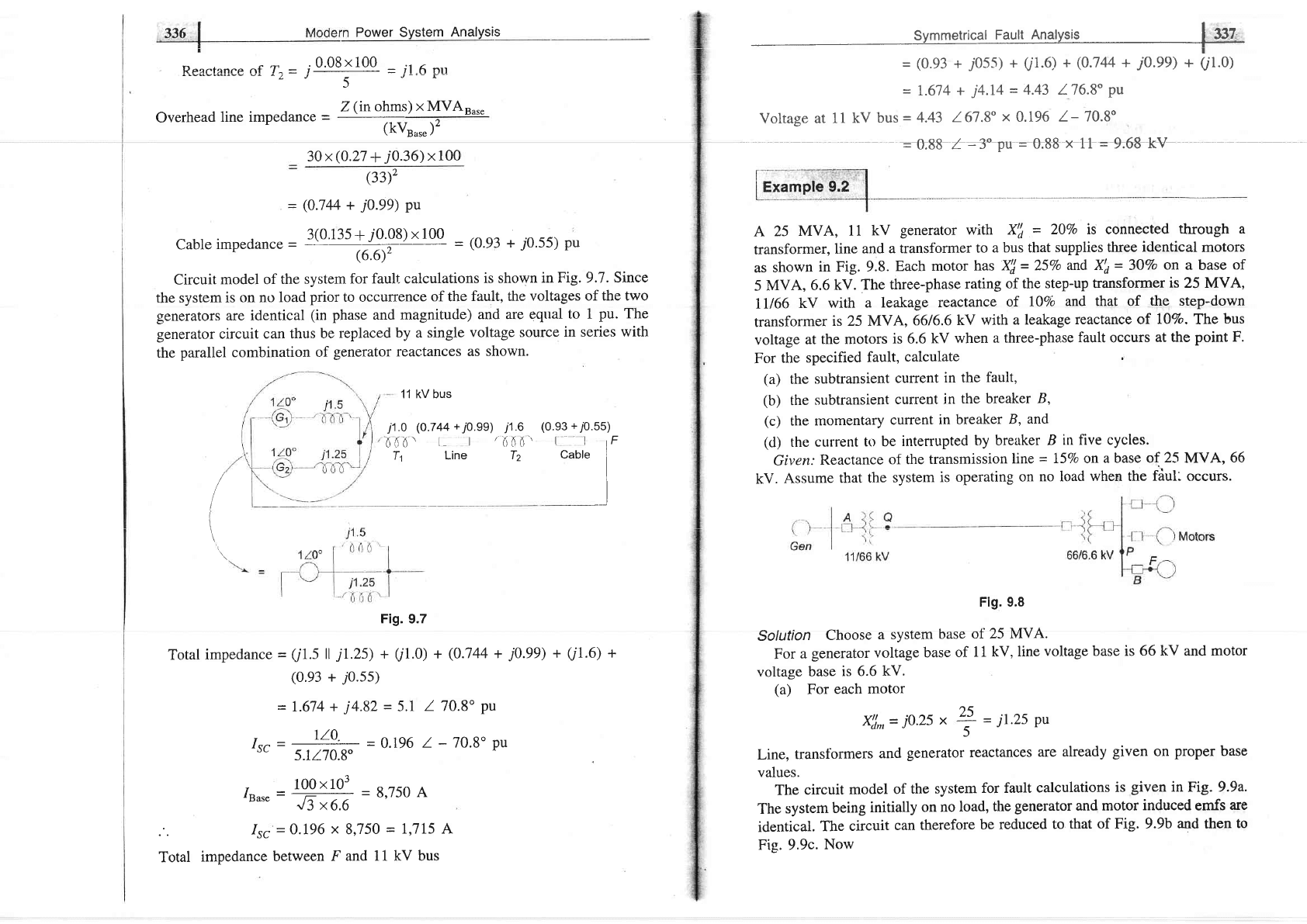
Power System
Analysis
Reactance of
Tr=
;WY4
=
71.6
pu
)
overhead
line impedance
-
Z
(in
ohms)
x MVA""'"
(kvBur"
)2
30x(0.27+j0.36)x100
Q'2
-
(0.744
+
70.99)
pu
cable
impedanc"
=
3(9-1!t,rJr0,q,
q21tlq
=
(0.93
+
70.55)
pu
(6.6)'
Circuit
model of
the system
for
fault calculations
is shown
in Fig. 9.7.
Since
the system
is on no
load
prior
to occurrence
of the
fault, the
voltages of
the two
generators are identical
(in
phase
and magnitude)
and are
equal
to 1
pu. The
generator circuit
can thus
be
replaced
by a single
voltage source
in series
with
the
parallel combination
of
generator reactances
as
shown.
Fig.
9.7
Total
impedance
=
(j1.5
ll
j1.25)
+
(t1.0)
+
(0.744
+
i0.99)
+
(i1.6)
+
(0.93
+
70.55)
-1.674
+
j4.82
=
5.1
170.8"
pu
Isc
=
''?
tt
=
0'196
I
-
70'8"
Pu
5.r170.8"
18u."
=
to*.10;
=
8,750
A
J3
x6.6
Isc
=
0.196
x
8,750
=
1,715 A
Total
irnpedance
between
F and
11 kV bus
i
55)
It
I
l
11 kV bus
j|.0
(o.744
+i0.99)
i1.6
(0.93
+70.
66d.
I
|
,
666'
I I
T1
Line
T2
Cable
I
Symmetrical
Fault
Analysis
|
337
I
=
(0.93
+
j05s)
+
(71.6)
+
(0.744
+
i0.99)
+
(t1.0)
=
I.674
+
j4.14
=
4.43 176.8"
pu
Voltage
at 11
kV
bus
=
4.43
167.8"
x
0.196
l- 70-8"
=
0;88
I
:T
ptt
=
ft88
x
11
=
9;68
kV
A
25
MVA,
11
kV
generator
with Xl
=
20Vo is connected
through a
transformer,
line
and
a transfbrmer
to a
bus that
supplies three
identical
motors
as
shown
in Fig. 9.8.
Each
motor
has Xj
=
25Vo
and Xl
=
3OVo
on a
base
of
5
MVA,
6.6
kV.
The
three-phase
rating
of the step-up
transformer
is
25 MVA,
11/66
kV with
a
leakage
reactance
of
l0o/o
and that of
the step-down
transformer
is 25 MVA,
6616.6
kV
with a
leakage
reactance of
l0%o.
The
bus
voltage
at
the motors
is 6.6
kV when
a three-pha.se
fault occurs
at the point
F.
For
the
specified
fault,
calculate
(a)
the
subtransient
current
in the
fault,
(b)
the
subtransient
current
jn
the breaker
.8,
(c)
the
momentary
current
in
breaker
B,
and
(d)
the
current
to be
interrupted
by breaker
B
in five cycles.
Given:
Reactance
of the
transmission
line
=
l5%o on
a base of
25
MVA,
66
kV.
Assurne
that
the
system
is
operating
on
no load
when the
fdul"
occurs.
Flg. 9.8
Sotution
Choose
a system
base
of 25
MVA.
For
a
generator
voltage
base
of
11 kV,
line
voltage base is
66 kV and motor
voltage
base
is 6.6
kV.
(a)
For
each
motor
X',j*
=
j0.25
x
Line,
transtbrmers
and
generator reactances
are
already
given
on
proper
base
values.
The
circuit
model
of
the
system
for fault
calculations
is
given
in
Fig.
9.9a.
The
system
being
initially
on
no
load,
the
generator
and
motor induced emfs
are
identical.
The
circuit
can
therefore
be
reduced
to
that of Fig. 9.9b
and
then
to
Fis. 9.9c.
Now
+
=
i1.25
pu
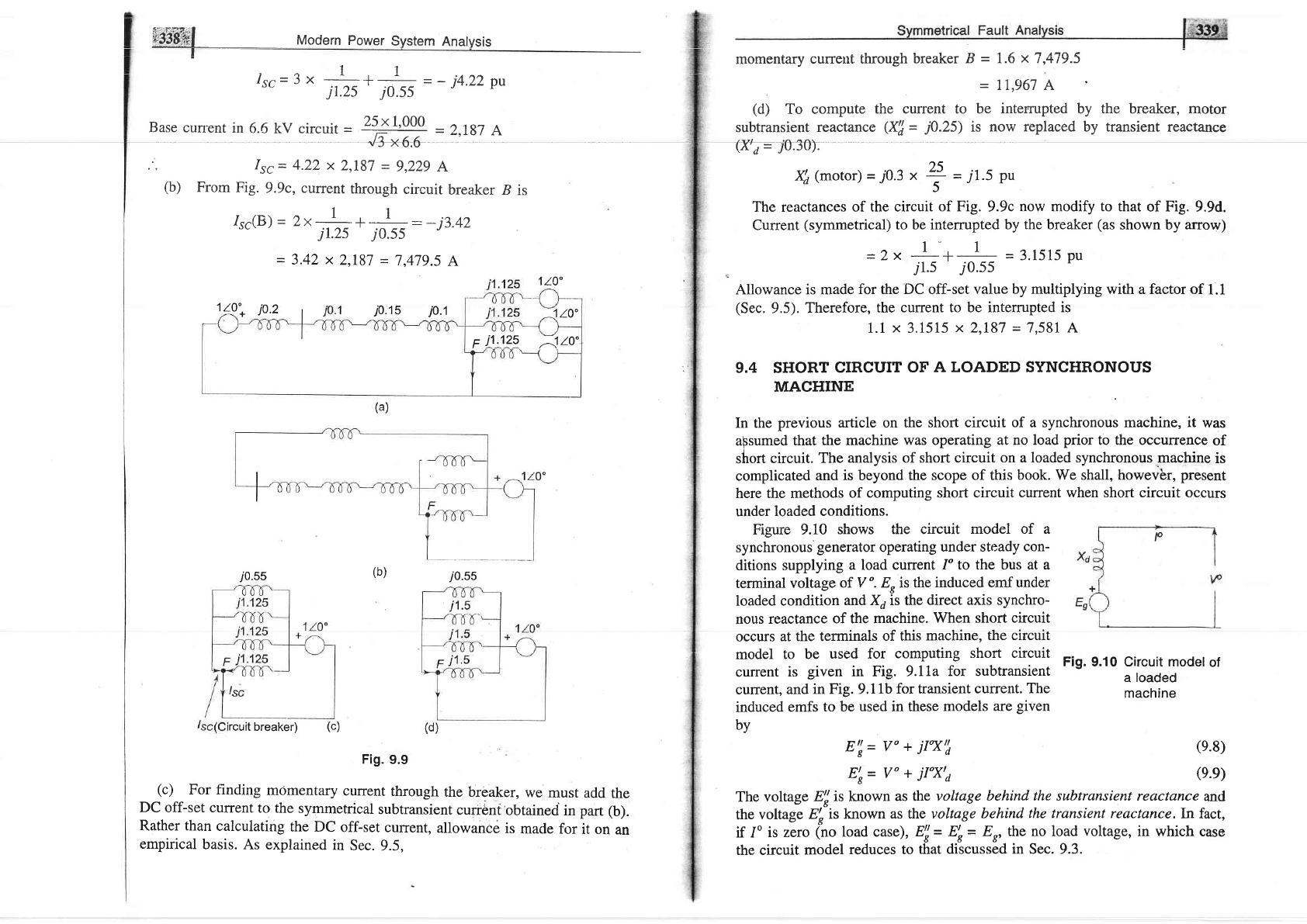
fiffirel
Modern
power
System
Anatysis
!
Isc=3><
--l-+=+
--
j4.22pu
j1.25
j0.55
r
Base
cun'ent
in
6.5
kV circui,
-
25 x
1,000
=
2.187
A
Issc=
o,;; *
r4rrlt]frf*
o
(b)
From
Fig.
9.9c, current
through
circuit
breaker
B
is
Isc(B)
-
2x-++.]_
:-i3.42
'
j1.25
j0.55
r
-. -
110'
jo.2
+
=
3.42
x
2,187
=
7,479.5
A
j0.15
j0.1
110"
110'
(b)
i0.55
Fig.
9.9
(c)
For finding
momentary
current
through
the breaker,
we
must add
the
DC off-set current
to the
symmetrical
subtransient
current
obtained
in
part
(b).
Rather than
calculating
the
DC
off-set
current,
allowance
is
made
for
it on
an
empirical
basis. As
explained
in
Sec.
9.5,
rcuit
breaker)
(c)
F
tll?9
;<
to"
i0.55
momentary
curreni ihrough
breaker B
--
1.6
x
7,4i9.5
-
17,967 A
(d)
To
compute
the current to be
intemrpted
by
the
breaker, motor
subtransient
reactance
(X!j
= j0.25)
is now
replaced
by transient reactance
(X
a
=
/0.3O).
XI
(motor)
=
70.3
x
The reactances
of the circuit
of Fig.
9.9c
now modify to that
of Fig. 9.9d.
Current
(symmetrical)
to be intemrpted by
the
breaker
(as
shown by arrow)
1" 1
=2x
^
+
=3.1515pu
jl.s jO.ss
Allowance
is made for
the DC off-set value
by
multiplying
with
a factor of
1.1
(Sec.
9.5).
Therefore,
the
current to be interrupted is
1.1
x
3.1515
x
2.187
=
7.581 A
9.4 SHORT
CIRCUIT
OF A
LOADED SYNCHRONOUS
MACHINE
In the
previous article on the
short circuit of a synchronous machine, it
was
aBsumed
that
the machine
was
operating
at no load
prior
to the occurrence
of
short
circuit.
The analysis
of short circuit
on a loaded synchronous
machine
is
complicated
and is beyond
the scope of this
book. We
shall, howevbr,
present
here the methods
of
computing short circuit
current when short circuit occurs
under loaded
conditions.
rl:---^ f\ 1/.| ^L^.-,^ +L^ ^i-^.,i+ *^A^l ^f
lr rBtlc >.
Lv Slluws
Llrg urrUurt
lrlu(lEl ur a
synchronous
generator
operating
under steady
con-
ditions supplying
a load
current /" to the
bus at a
terminal
voltage
of V
".
E, is the
induced
emf under
loaded condition
and Xa is the
direct axis synchro-
nous reactance
of the machine.
When short circuit
occurs
at
the terminals
of this
machine,
the circuit
model
to be
used for
computing
short circuit
current
is
given
in Fig. 9.11a
for subtransient
current,
and
in Fig. 9.1lb
for transient
current. The
induced
emfs
to be
used in these models
are
given
bY
E,l= v"
+
ilTtj
EL- V'+
il"Xto
The
voltage
E!is known
as the voltage
behind
the
subtransient
reactance
and
the
voltage
E!is
known
as the voltage
behind
the transient
reactance.Infact,
if 1o
is zero
(no
load
case),
EJ= Etr=
Er, the no load voltage, in
which case
the circuit
model
reduces to
that discussed
in
Sec. 9.3.
25
T
=
Jr.)
pu
Fig.
9.10 Circuit model
of
a
loaded
machine
(e.8)
(e.e)
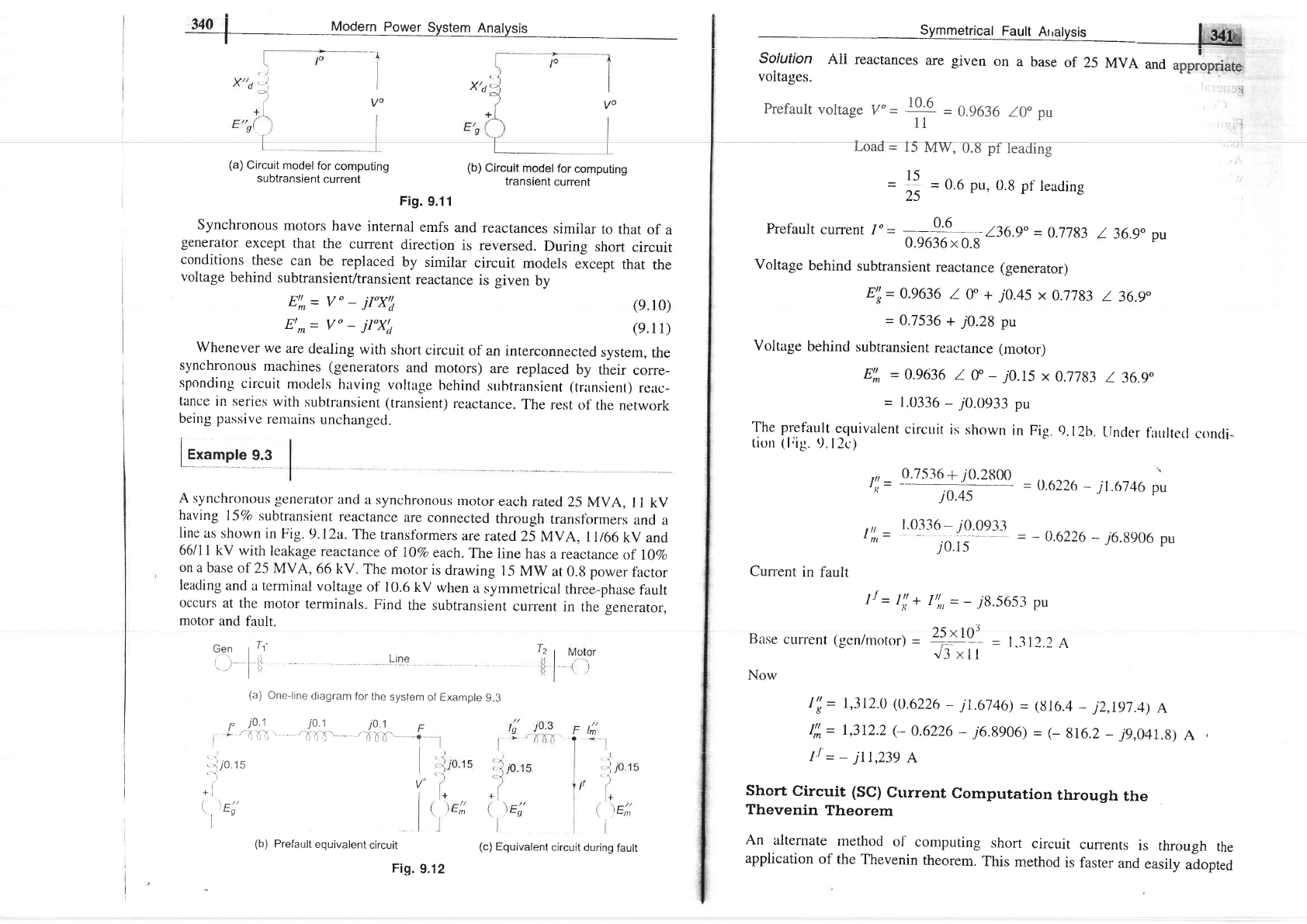
340
|
Modern
po*s1_qqe!l
inslygs
I
t/o
Fig.
9.11
Synchronous
motors
have
internal
emfs
and
reactances
similar
to
that
of
a
generator
except
that
the
current
direction
is
reversed.
During
short
circuit
conditions
these
can
be replaced
by similar
circuit
moclels
eicept
that
the
voltage
behind
subtransient/transient
reactance
is
eiven bv
E'lr=
v"
-
jI"xU
E'*=
v"
-
jI"4
Whenever
we
are
dealing
with
short
circuit
of
an interconnected
system,
the
synchronous
machines (generators
and
motors)
are
replaced
by
their
corre-
sponding
circuit
moclels
having
voltage
behincl
srrhtransient
(transient)
reac-
tance
in
series
with
subtransient
(transient)
reactance.
The
rest
of
the
network
being passive
rentains
unchanged.
I
I
Example
9.3
r^_._
,
. ...- .:
".._
. ._ .
A synchronous
generator
and
a synchronous
motor
each
rated
25
MVA,
I
I kV
having
l5Vo
subtransient
reactance
are
connected
through
transfbrmers
and a
line
as
shown
in
F'ig.
9.12a. The
transfbrmers
are
ratecl
25
MVA.
lll66kV
and
66lll
kV with
leakage
reactance
of
l\Vo
each.
The
line
has
a
reactance
of lTTo
on
a base
of 25 MVA,
66 kv.
The
motor
is
drawing
15
Mw
at
0.9
power
factor
leading
and
a terminal
voltage
of 10.6
kV
when
a
symmetrical
three-phase
fault
occurs
at the
motor
terminals.
Find
the
subtransient
culrent
in the
generator,
motor
and
fault.
(a)
Circuit
modelfor
computing
subtransient
current
t"
j0.1
j0.1
j0.1
t
;
.6'f,1,'.
'dtI-.
-
'ltrd-.
I
.
,1i0.15
')
r
+l
I
(b)
Prefault
equivalent
circuit
(b)
Circuit
model
for
computing
transient
current
Gen
t
Tt'
| | '! Line
)
lr;
(a)
One-line
diagram
for
tho
systom
of
Example
9
3
F
-t
i
I
I
(c)
Equivalent
circuit
during
fault
Fi9.9"12
_Symmetrical
Fault
Arralysis
solution
Aii
reactances
are given
on
a
base
of
25
MVA
and
voiiages.
I
36.9" pu
I
36.9"
Current
in
fault
appropriatgi
:t
(e.10)
(e.11)
Prefault
voltage
V"
=
J'9
=
0.9636
l0 pu
l1
Load
=
15
NfW,
0.8
pflEading
=
l:
=
0.6
pu,
0.8 pf
leading
25
prefault
currenl
I"
=
_9{__
_
136.9.
=
0.77g3
0.9636
x
0.8
Voltage
behind
subtransient
reactance (generator)
E",
-
0.9636
I
tr +
j0.45
x
0.1783
-
0.7536
+
70.28
pu
Voltage
behind
subtransient
reactance (motor)
El,,
-
0.9636
/_
tr
-i0.15
x
0.7783
/_
36.9"
=
1.0336
-
.70.0933
pu
The plefurult.equivalent
circuit
is
shown
in
Fig.9.l2b.
Uncler
fhrrltecl
c.ncli-
tion
(lrig.
9.
l2c)
.,,
0.7536+
i0.21t00
I';,--
"
-=0.6226_j1.6746pu
"
i
0.45
1.03i6
-
ro oc)? 1
I',l,
=
i 0.1s
Base
Now
IJ=
I:i
+
1,,,,=_
jg.5653
pu
cttrre
nt
(gen/moto
I
=
44q1
=
1.3
12.2
A
J3
xll
I'J
-
1,312.0
(0.6226
-
j1.6746)
=
(816.4
_
jL,tgt.4)
A
I'J=
1,312.2 (.-
0.6226
-
j6.8906)
=
(-
816.2
_
jg,O4L8)
A
1t--jtt,23gA
short
circuit (sc)
current
computation
through
the
Thevenin
Theorem
An
alternate
method
ol'
cornputing
short
circuit
application
of
the Thevenin
theorem.
This
method
is
currents
is
through
the
faster
and
easily
adopted
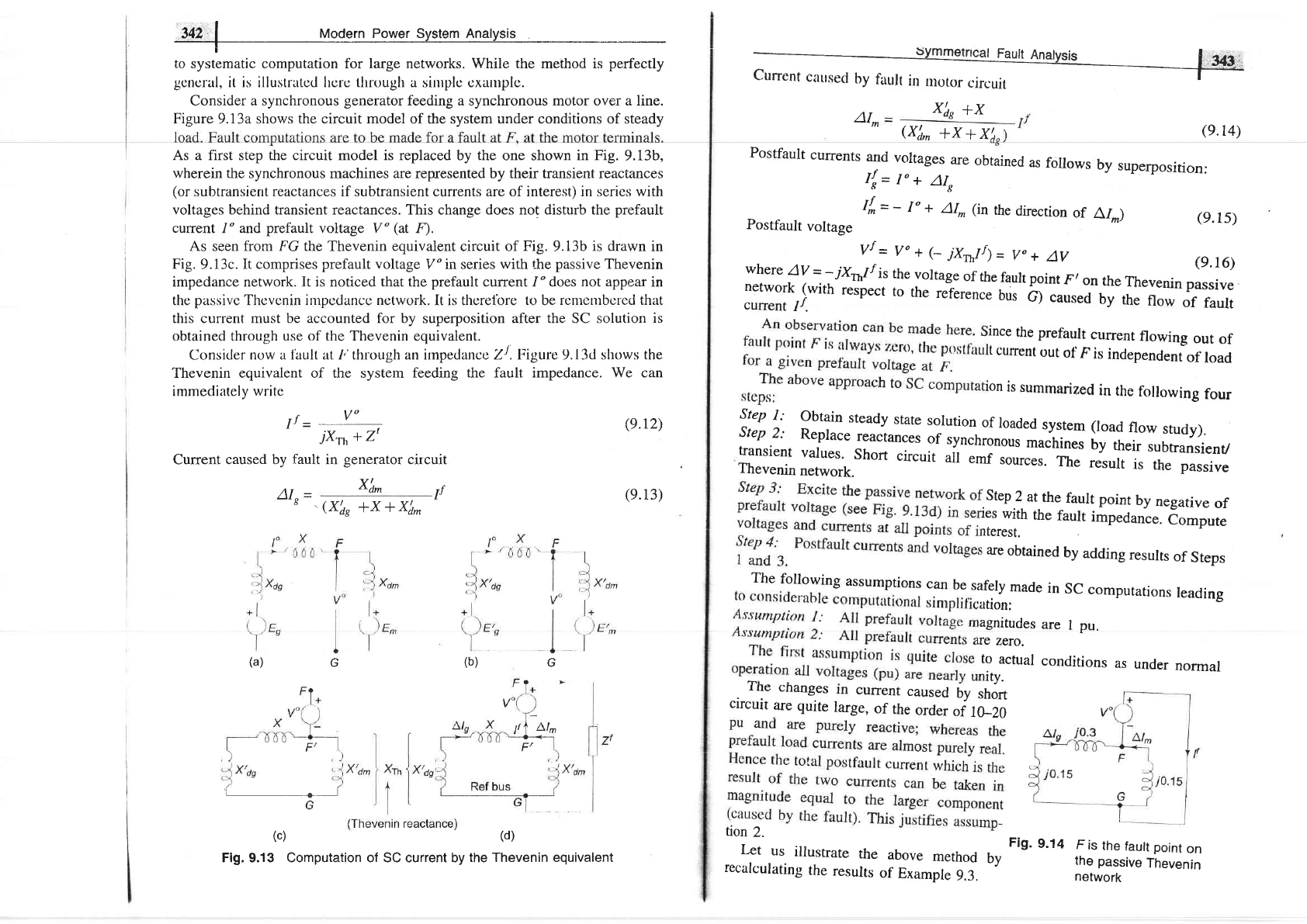
I
342
|
Modern Po*er System Analysis
I
to
,yrtl-atic computation for large networks. While the method is
perfectly
gcncrerl,
it rs illustratcd hcrc tlrrough a
sinrplc
cxanrplc.
Consider a synchronous
generator
feeding a synchronous motor over a line.
Figure
9.I3a shows the
circuit model
of the system under conditions of steady
As a first step the circuit
model
is replaced
by
the
one shown in
Fig.
9.13b,
wherein the
synchronous machines are represented by their transient reactances
(or
subtransient reactances
if subtransient
currents are of interest) in series with
voltages behind transient reactances. This change does not disturb the
prefault
current
I" and
prefault
voltage V"
(at
F).
As seen from
FG
the Thevenin
equivalent
circuit of Fig. 9.13b
is drawn
in
Fig.
9.13c.
It comprises
prefault
voltage
V"
rn series
with
the
passive
Thevenin
impedance network. It is noticed that the
prefault
current 1" does
not appear
in
the
passivc
Thcvcnin irnpcdancc nctwork. It is thcretore t<l be
rcmcnrbcrcd that
this current must be accounted for by
superposition
after the SC solution is
obtained through
use of the Thevenin
equivalent.
Consider
now a lault at 1,' thlough an irnpedance Zl .liigure
9.13d
shows the
Thevenin equivalent of the system feeding
the
fault
impedance. We can
immediately
write
AI^
+X
(xlh,
+x
+
xi
Xle
(e.14)
,l'-
-
V"
'
jXrn
+ Zt
Current caused by
fault
in
generator
circuit
Postfault
currents
and
voltages
are
obtained
as
follows
by
superposition:
I{=
I"
+
alr
I{=-
I"
+
AI^ (in
rhe
direction
of
AI^)
(9.15)
Postfault
voltage
vf
-=
vo
+
(-,rxn,If)
=
v"
+
Av
eJ6)
where
Av
=
-ix^tf
is
the
voltage
of
the
fault
point
F/
on
the
Thevenin
passive
fffl:liiwith
respect
to
the
reference
bus
ct-;;;..d
by
the
flow
-of
faurt
ince
the
prefault
current
flowing
out
of
t
curent
out
of
F.
is
independeniof
load
on
is
summarized
in
the
following
four
Step
I:
Obtain
steady
state
solution
of
loaded
system
step
2:
Replace
reactances
of
synchronous
machines
transient
values.
Short
circuit
uit
"rr
sources.
The
Thevenin
network.
'Step
2
at
the
fault
point
by
negarive
of
ies
with
the
fault
impedanc".
6o_pur"
rterest.
r
are
obtained
by
adding
results
of
Steps
The
following
assumptions
can
be
safery
made
in
SC
computations
reading
:ation:
ragnitudes
are
I pu.
tre
zero.
to
actual
conditions
as
under
normal
nity.
ruc
cnanges
ln
current
caused
by
short
circuit
are
quite
large,
of
the
order
of
10_20
(load
flow
study).
by
their
subtransienU
result
is
the
passive
x'd^
fAI,
-
-
(xhs
+x
+
xl^
(b)
G
(a)
G
tion
2.
Let
us
illustrate
the
above
method
b,
Fi9'e't+
recalculating
the
results
of
Example
9.3.
F
is
the
fault point
on
the
passive
Thevenin
network
(c) (d)
Fig. 9.13 Computation of SC current by
the Thevenin equivalent
(e.r2)
(e.13)
